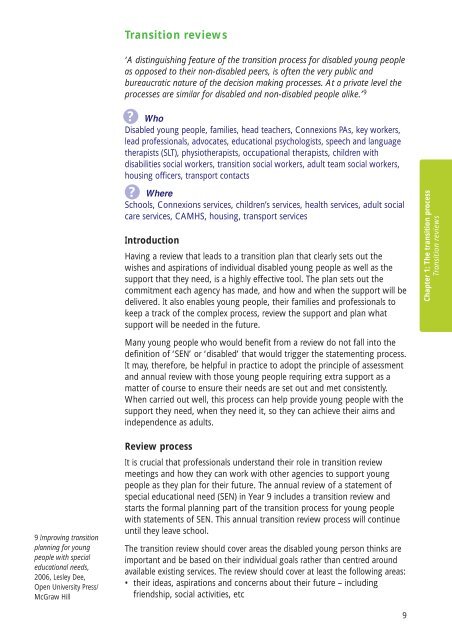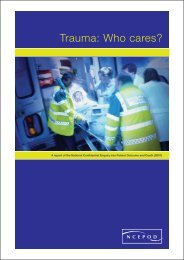A Transition Guide for All Services - Transition Information Network
A Transition Guide for All Services - Transition Information Network
A Transition Guide for All Services - Transition Information Network
- No tags were found...
Create successful ePaper yourself
Turn your PDF publications into a flip-book with our unique Google optimized e-Paper software.
<strong>Transition</strong> reviews‘A distinguishing feature of the transition process <strong>for</strong> disabled young peopleas opposed to their non-disabled peers, is often the very public andbureaucratic nature of the decision making processes. At a private level theprocesses are similar <strong>for</strong> disabled and non-disabled people alike.’ 9?WhoDisabled young people, families, head teachers, Connexions PAs, key workers,lead professionals, advocates, educational psychologists, speech and languagetherapists (SLT), physiotherapists, occupational therapists, children withdisabilities social workers, transition social workers, adult team social workers,housing officers, transport contacts?WhereSchools, Connexions services, children’s services, health services, adult socialcare services, CAMHS, housing, transport servicesIntroductionHaving a review that leads to a transition plan that clearly sets out thewishes and aspirations of individual disabled young people as well as thesupport that they need, is a highly effective tool. The plan sets out thecommitment each agency has made, and how and when the support will bedelivered. It also enables young people, their families and professionals tokeep a track of the complex process, review the support and plan whatsupport will be needed in the future.Chapter 1: The transition process<strong>Transition</strong> reviewsMany young people who would benefit from a review do not fall into thedefinition of ‘SEN’ or ‘disabled’ that would trigger the statementing process.It may, there<strong>for</strong>e, be helpful in practice to adopt the principle of assessmentand annual review with those young people requiring extra support as amatter of course to ensure their needs are set out and met consistently.When carried out well, this process can help provide young people with thesupport they need, when they need it, so they can achieve their aims andindependence as adults.9 Improving transitionplanning <strong>for</strong> youngpeople with specialeducational needs,2006, Lesley Dee,Open University Press/McGraw HillReview processIt is crucial that professionals understand their role in transition reviewmeetings and how they can work with other agencies to support youngpeople as they plan <strong>for</strong> their future. The annual review of a statement ofspecial educational need (SEN) in Year 9 includes a transition review andstarts the <strong>for</strong>mal planning part of the transition process <strong>for</strong> young peoplewith statements of SEN. This annual transition review process will continueuntil they leave school.The transition review should cover areas the disabled young person thinks areimportant and be based on their individual goals rather than centred aroundavailable existing services. The review should cover at least the following areas:• their ideas, aspirations and concerns about their future – includingfriendship, social activities, etc9
















